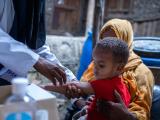Note: This article was updated on Jul 16, 2002, with comments from a senior health economist at CDC on the study discussed.
Jul 15, 2002 (CIDRAP News) If terrorists unleashed smallpox in a large city, mass vaccination would save thousands more lives and stop the outbreak months earlier than a vaccination campaign limited to contacts of infected people would, according to a mathematical model described in the Proceedings of the National Academies of Science.
In view of their findings, the authors say the Centers for Disease Control and Prevention (CDC) should reconsider its interim smallpox response plan, which calls for a targeted vaccination program and isolation of patients, with a switch to mass vaccination if necessary.
"Given our current states of knowledge and response capabilities . . . we believe that unless preattack vaccination is used to significantly increase herd immunity in the population, serious consideration should be given to replacing the existing CDC policy by MV [mass vaccination] in the event of a smallpox attack in a large urban center," states the report by Edward H. Kaplan of Yale University and two colleagues from the Massachusetts Institute of Technology.
The report comes as the public health community awaits a decision on federal smallpox vaccination policy by Health and Human Services Secretary Tommy Thompson. In June, the CDC's Advisory Committee on Immunization Practices (ACIP) recommended that pre-attack vaccinations be limited to teams of healthcare and security personnel who will be assigned to deal with bioterrorist attacks, and to some staff members in designated hospitals. The ACIP did not recommend changing the emergency response strategy of targeted or "ring" vaccination.
The new report projects that in an attack that initially infected 1,000 people, mass vaccination would limit the epidemic to 1,830 cases with 560 deaths over 115 days, whereas "traced" vaccination would permit 367,000 cases and 110,000 deaths in a 350-day epidemic. The model assumes that for effective vaccination, people must be inoculated within 3 days after exposure to smallpox. The time necessary to identify and trace contacts would often prevent vaccinators from reaching them in time, the report states. "Contact tracing can control a smallpox epidemic only if the race to trace is repeatedly won."
The authors' scenario assumes that each index patient would transmit smallpox to three contacts (a reproductive rate of 3), that vaccinations would begin 5 days after the attack, that index patients would name half of their contacts, and that 5,000 nurses would be available to trace and vaccinate people. When the researchers tried a wide range of different values for the population initially infected, the reproductive rate, and the number of vaccinators available, they found that mass vaccination would save lives and shorten the epidemic in nearly all scenarios. For example, if index patients named all their contacts, mass vaccination would still lead to fewer deaths so long as the reproductive rate exceeded 2. Traced vaccination would be optimal only if decision-makers could be very confident that the initial attack was very small and the reproductive rate very low, the report says.
The authors also simulated use of the current CDC guidelines by assessing what would happen if health officials changed the response strategy from traced to mass vaccination 28 days into the campaign. In that scenario, the epidemic would involve 15,570 cases and 4,680 deaths over 165 days, a far lower toll than with traced vaccination alone, but still would cause 4,120 more deaths than would occur with immediate mass vaccination.
The report notes that the CDC policy is based on the surveillance-and-containment strategy used successfully in the campaign to eradicate smallpox worldwide. The article says the new findings are not inconsistent with the history of the eradication effort, because in many past outbreaks, initial cases were relatively few, the affected populations already had a high level of herd immunity, and contact tracing was very accurate because the outbreaks were in isolated villages. These factors would favor traced vaccination over mass vaccination, the report says.
The authors conclude, "Compared with MV, TV [traced vaccination] slows the overall vaccination rate, which lengthens the time until herd immunity is reached. As a consequence, the infection continues to spread, potentially increasing the trace/vaccination burden to the point at which significant congestion occurs." In turn, this congestion "makes losing the race to trace more likely."
In mass media reports since the publication of the study, Kaplan has advocated advance planning for local mass immunizations so that campaigns could be conducted efficiently if a smallpox attack occurred.
Martin Meltzer, PhD, a CDC senior health economist who has studied Kaplan's report, told CIDRAP News that the mathematical model used in the study is sound, but said at least two of the assumptions used in it are open to question. Meltzer works in the Office of Surveillance at the CDC's National Center for Infectious Diseases in Atlanta.
First, Meltzer said, the report assumes that all smallpox transmission occurs when the patients are in stage 3 of the disease. The authors defined this as the stage when the patient is infectious but asymptomatic, meaning no rash has appeared, and said this stage lasts 3 days on average. But historically, this is not what has happened, Meltzer said. "In the first 3 days, you infect less than 20% of the people you're going to infect," he said. "The majority of the people you're going to infect would be during the time when you have a rash."
Meltzer said he wasn't sure how changing this parameter would affect the model's projections, because he has not tried it. But, he said, "If you collapse it [the period of transmission] down to 3 days, you're handicapping the race to trace, because you have to trace all the contacts in the first 3 days." Overall, more people might have to be vaccinated than the model suggests, he said. "But the number of people infected in the first 3 days would be much less, I believe, than what they suggest."
Meltzer's second concern had to do with how many contacts of the index patients would be vaccinated in time. The authors' main scenario assumes that patients would recall only half of their contacts. Meltzer said the study appears to assume that contact tracers would rely mainly on the actual naming of contacts by the index patients, the same approach in containment of sexually transmitted diseases. But in smallpox containment, investigators would cast a broader net by asking patients about all their activities and using that information to hunt for contacts, he said.
Consequently, he said, vaccinators might be able to reach more contacts than the model assumes. "The bottom line is that tracing and vaccination might be more efficient than they've allowed for." As with the disease transmission issue, he said he didn't know how much this would change the model's predictions, but added, "Sometimes in models, making very small changes like this can make a big difference."
Kaplan EH, Craft DL, Wein DL. Emergency response to a smallpox attack: the case for mass vaccination. Proc Nat Acad Sci, early edition (pdf version)
http://www.pnas.org/cgi/reprint/162282799v1.pdf


















